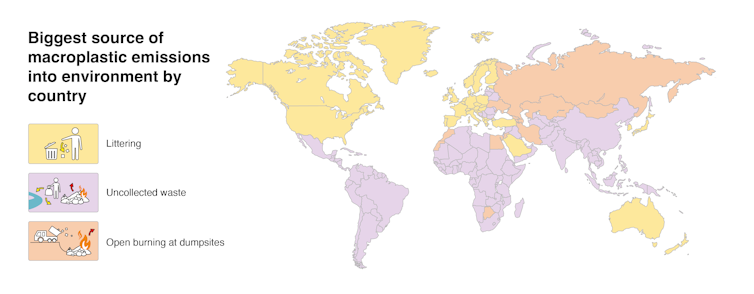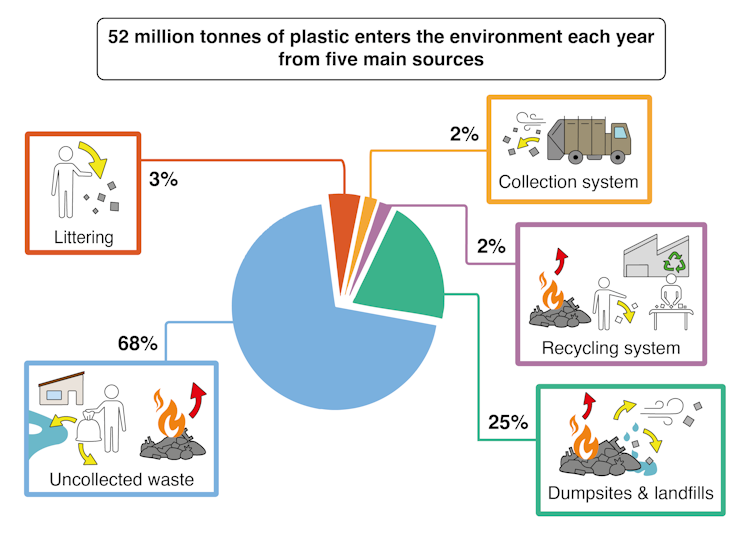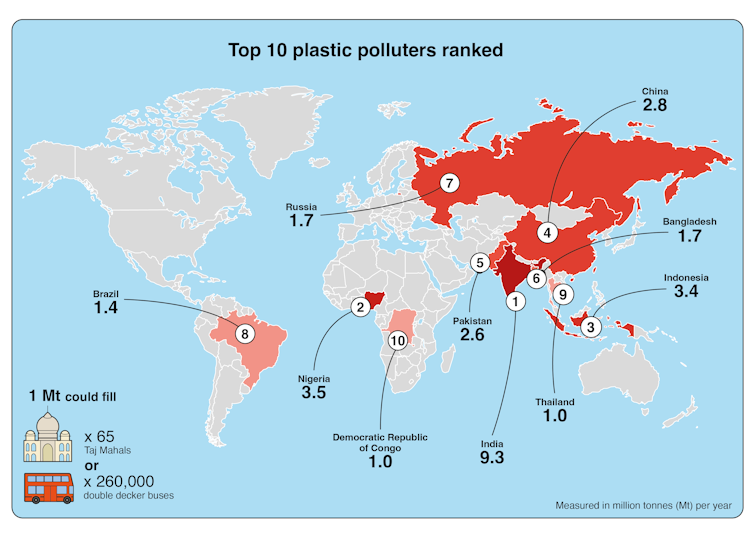Costas Velis, University of Leeds; Ed Cook, University of Leeds, and Josh Cottom, University of Leeds
We have used machine learning to identify the biggest plastic pollution hotspots across more than 50,000 towns, cities and rural areas worldwide. Our new global model reveals the most detailed picture of plastic pollution ever created with the highest environmental concentrations in India, predominantly because so much of its waste isn’t collected.
Plastic has been found everywhere – from deep ocean trenches to the highest mountain tops, but these observations only reveal isolated snapshots of the overall plastic pollution picture. A bigger challenge is to find out where and how this plastic reaches the environment in the first place, so pollution can be prevented at source.
This is no easy task. The most challenging aspects to measure are the “emissions” – the macroplastic (anything bigger than 5mm in size) that escapes or is released from material systems and activities. This includes waste blowing from rubbish bins or falling off collection trucks plus litter being dropped by people, either accidentally or intentionally.
We found that littering is the largest emission source in the developed world where waste management systems are highly controlled. Conversely, in developing countries uncollected waste is the dominant source.

Using artificial intelligence, our new computer model shows how plastic moves from a controlled system into the environment where it becomes very challenging to recapture and contain. We had to work out how plastic escapes from the controlled system and found that, of the 52 million tonnes of waste (equivalent to the weight of 8.7 million African grey elephants) which enters the environment each year, uncollected waste is the biggest source. That’s about 68% by weight of all pollution or 36 million tonnes each year.
So it’s a misconception that plastic pollution is caused by people’s irresponsible behaviour. The main reason is that 1.2 billion people do not have their solid waste collected at all. Instead, they have to burn, bury or scatter it on land or in the water.

Open burning of waste is prolific, accounting for 57% of all plastic pollution worldwide by weight. This involves burning waste on open fires without any controls to prevent hazardous emissions from reaching the environment or harming our health. This practice is popular, possibly because it seems to make the waste disappear, reducing the burden on waste management authorities and reducing the unsightliness of waste dumped on land.
India has emerged as the largest plastic polluter, emitting 9.3 million tonnes of plastic into the environment each year – one fifth of the total. That’s 2.7 times more than the next two largest polluters, Nigeria and Indonesia.

India comes top because only 81% of its waste is collected. But, it also generates a lot more waste than some previous models have assumed. Official government sources estimate 0.12kg per person per day, but these estimates exclude many rural areas, so the real number is closer to 0.54kg per person per day. The combination of such a large amount of waste, large population and low collection rate creates the conditions under which plastic pollution flourishes.
Targeted action
Pinpointing these pollution hotspots helps policymakers design more targeted ways to deal with plastic pollution. Countries with higher plastic pollution usually have fewer resources, in terms of money and infrastructure. So they tend to be least well-equipped to curb their emissions.
Having a more detailed understanding of how waste is managed and emitted in every corner of the world enables governments to target their scarce resources at the areas where plastic pollution is most acute. Our model will also help them to develop action plans that can feasibly meet the targets agreed in the global plastics treaty, an international agreement that’s currently being negotiated to reduce plastic pollution worldwide.
Reducing our consumption of plastic is one solution to curb plastic pollution. But plastic does not exist in isolation. It’s part of a complex mixture of materials in waste and we need to consider all of them together. For example, food waste, along with other biodegradable materials, produces most of the climate emissions from the waste management system when it is deposited in land disposal sites.
If we cut down on plastics, we will need to think of ways to reuse materials or replace them with others. But our previous research has shown that the opportunities to do so are limited and in practice – we’ll be making plastic long into the future. Right now, we need to manage our plastic waste more effectively. Finding ways to extend waste collection services could dramatically reduce plastic pollution and benefit billions of people.
Costas Velis, Lecturer in Resource Efficiency Systems, University of Leeds; Ed Cook, Research Fellow in Circular Economy Systems for Waste Plastics, University of Leeds, and Josh Cottom, Research Fellow, Plastics Pollution, University of Leeds
This article is republished from The Conversation under a Creative Commons license. Read the original article.











